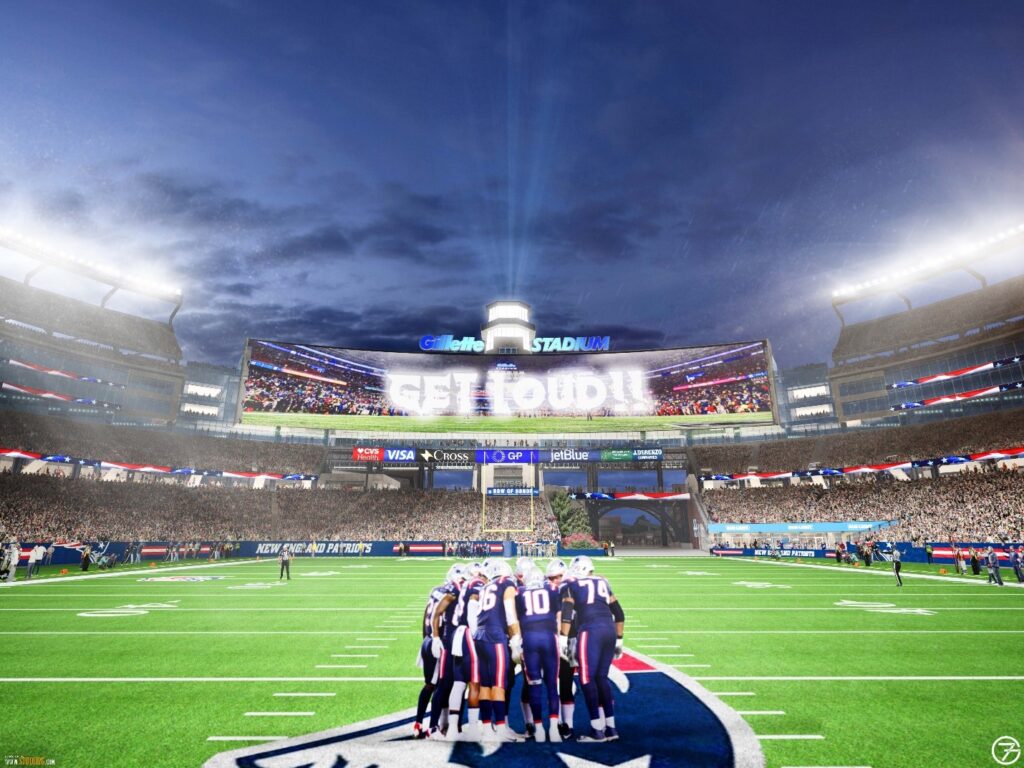We live in an age where virtually anyone can install an 80-inch TV and surround sound systems in their home. So, owners of professional sports teams and concert venues must work hard to continuously provide a differentiated experience for fans attending events in person. In case the roar of the crowd and the excitement of being there isn’t enough, these organizations continue to modernize and improve the live experience in these stadiums.
Recently, I was able to get a behind-the-scenes tour of the newly renovated Gillette Stadium, home of the New England Patriots and New England Revolution, to better understand how they are improving in-person experiences. If you are not aware, Gillette Stadium recently underwent a significant renovation in its north end zone to provide additional hospitality services, a massive outdoor screen, and modernize its video network to support broadcast TV, security and safety, and eventually deliver video content to the screens distributed throughout the stadium. Regardless of where you are, you never miss a play.
For those attending the game/event, it is impossible to miss the massive outdoor screen in the north end zone. This 22,000-square-foot screen (for context, that is almost half an acre) is the largest curved outdoor HD video board in the U.S. And in case you are wondering, no, this will not fit in your living room. Being over five times larger than the video board it replaced, it provides a great view of the action taking place on the field for almost the entire stadium. And of course, the new 22-story lighthouse with an observation deck behind the board is also quite distinctive.

While these additions have a dramatic visual impact, it is really what is going on behind the scenes that provides the more differentiated experience. A big part of this renovation was creating an in-house video production studio for the stadium. So, while production trucks will still be required for uplinks, all the game video feeds now run through this production room. This allows the stadium to control the content going to the screens in the stadium and why those attending the game get to see replays (NFL, MLS) on the big screen before those at home do—if at all. To always ensure high availability, the stadium leverages redundant on-premises data centers and multiple redundant network connections on each side of the stadium. As a side note, the data center environment we toured was as impressive as the screen—not a wire out of place—and everything was labelled according to the standards of the Kraft Group (owners of the Patriots and Revolution). To ensure all the video feeds can be collected from the cameras, then viewed in the production room, and delivered to broadcasters and the video screens, Gillette Stadium turned to Cisco Systems network technology for a wired solution that was designed and implemented by the Acadia Technology Group. The deployment also included the infrastructure to support the main press conference room as well as several breakout Cisco WebEx interview rooms.
In addition to game/event day, Gillette Stadium also created an operations control room to improve operational efficiencies. Again, aided by dozens of video panels, this main operations control room tracks weather, real-time automobile traffic, and foot traffic in and around the stadium. Aided by AI technology that can quickly alert this team, comprised of Gillette Stadium staff, local, state, or federal officials, of any issues that need to be addressed. For example, the AI-enabled scene analytics software could detect something as simple as a full trash can and alert maintenance to empty it or monitor inventory levels in self-checkout kiosks so staffers can ensure products are always available, to detecting a fan trying to scale a fence to an unauthorized area, which would alert security teams to act. Ultimately, this enables Gillette Stadium staff to provide the best possible and safest experience on game day or event.
As an aside, it is worth noting that Micheal Israel, the Kraft Group CIO who led the tour, is also in charge of the other Kraft businesses and that the innovative technology deployed at the stadium often gets implemented at the other Kraft Group locations to deliver greater operational efficiencies and safety. The aforementioned AI-enabled scene analytics capability and Cisco networks are just a few of the technologies that have been implemented, and they have led to improved processes and productivity at the Kraft Group recycling plants.
Why does all this matter? It demonstrates the value that innovative technology can have in improving not just a game day or concert experience but also any business process. Stadiums such as Gillette, SoFi Stadium in Los Angeles, Allegiant Stadium in Las Vegas, and others continue to use technology to deliver a differentiated and safe game day/concert experience. Video, Wi-Fi, and 5G networks all play a role in enabling these massive stadium environments to deliver an enhanced experience. It’s great to see Gillette Stadium (and the Kraft Group) continue to innovate and share their experiences with other stadiums to raise the bar for all stadium events. More importantly, businesses outside of sports and entertainment can learn from these technology deployments and leverage them to improve their own process, product, or ensure a safe and productive work environment—or provide a differentiated experience to their employees!







